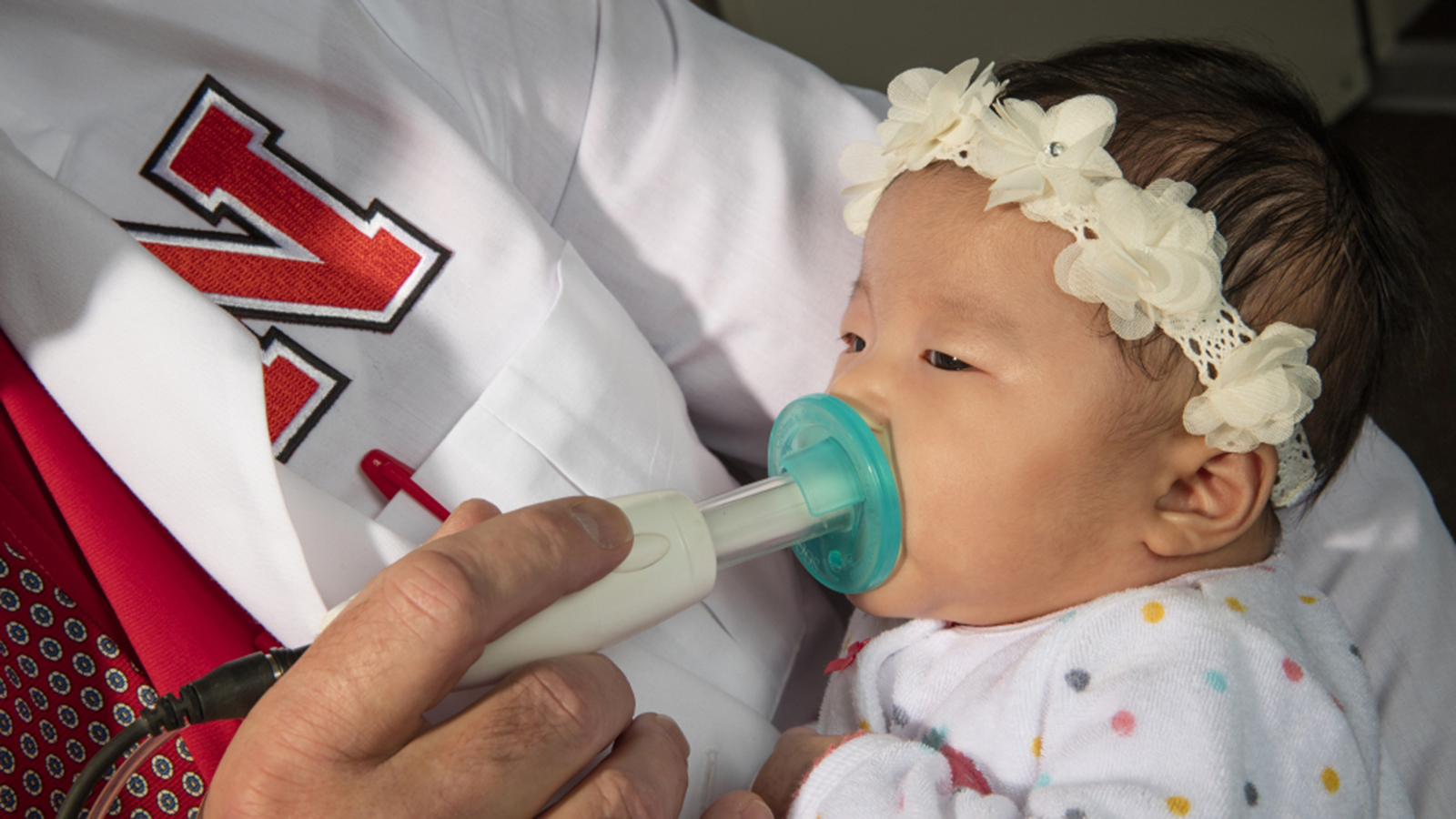
Early results from NIH study show promise for helping preterm infants
01 Dec 2021 By Tiffany Lee, Office of Research & Economic Development
November is National Prematurity Awareness Month, a time to recognize the challenges faced by the 15 million babies around the world who are born each year before 37 weeks of gestational age. Because these babies miss out on crucial developmental processes that happen in the womb during the last few months of pregnancy, they can face a host of short- and long-term health problems, including cardiac, respiratory and neurological complications.
The University of Nebraska-Lincoln’s Steven Barlow is six years into a $2.8 million project funded by the National Institutes of Health aimed at helping preterm babies conquer a problem that sometimes flies under the radar, yet is a major driver of long, expensive stays in the neonatal intensive care unit, or NICU: the inability to eat on their own.
“It’s surprising to a lot of people that the last big hurdle in order to be discharged from the hospital is that the baby needs to develop and demonstrate independent oral feedings,” said Barlow, Corwin Moore Professor of special education and communication disorders and associate director of the Center for Brain, Biology, and Behavior. “All of the other systems – brain, lungs, heart – may be looking pretty good diagnostically, but the baby still can’t feed. You don’t want to send a preterm infant home in the care of parents if there’s a significant risk of aspiration.”
That’s why Barlow spent much of the 1990s and early 2000s developing the NTrainer System, which sends pressure pulses through a pacifier to teach babies the rhythm of non-nutritive sucking and prepare them for the suck-swallow-breathe pattern that’s essential to safe oral feeding. The Food and Drug Administration approved the medical device in 2008, and it’s currently used in hospitals across the nation.
In the current NIH study, Barlow and about 20 collaborators from across the country are working to determine the efficacy of a more sophisticated version of NTrainer therapy for extremely pre-term babies, defined as those born between 24 and 29 weeks gestational age. They’re also exploring how the NTrainer intervention affects six genes that play a role in brain and neuromuscular development underlying infant feeding, with the long-term goal of enabling physicians to develop individually tailored plans of care for babies struggling to feed in the NICU.
Barlow’s team is the only one worldwide developing a genetics-based approach to pinpointing a premature infant’s progress toward independent feeding.
“The advantage to a rt-PCR gene expression test is that it would be relatively quick and low cost,” he said. “It would provide neonatologists and nurse practitioners with objective, molecular-based data to use in determining if the brain is ready to feed, if the gut is ready to feed, and if the neuromuscular substrates of the orofacial and swallow mechanism are actually ready to take a bolus, rather than relying on trial-and-error guesswork.”
Trial-and-error is problematic when the consequences of error can be so dire, Barlow said. If even a microdroplet of nutrient goes to the trachea rather than the esophagus of an extremely premature infant, the result could be pneumonia or even death.
Early results from the study are promising. The team collected saliva droplets using repeated sampling over a period of 10 or more weeks from 117 extremely preterm babies enrolled at four NICUs across the country: CHI St. Elizabeth’s in Lincoln; Santa Clara Valley Medical Center in San Jose, California; Tufts Medical Center in Boston, Massachusetts; and Children’s Hospital of Orange County in Los Angeles, California. Some received the new progressive NTrainer therapy for four weeks, while the control group received a sham, which is essentially a typical, non-pressurized pacifier.
“What we discovered is that these extremely preterm infants show a very significant therapeutic benefit from NTrainer on central pattern generation and development of their sucking skills, and dramatic improvement in their transition to the attainment of oral feeding skills,” Barlow said.
Success was measured by length of NICU stay and metrics related to the biomechanics of sucking and growth in oral feeding, which were determined through advanced analytics, linear mixed modeling and machine learning methods. The team recently presented its findings to the Pediatric Academic Society meeting and other international conferences.
Barlow said the team has also unexpectedly uncovered sex-based differences in the babies’ feeding abilities. Early data indicate that girls are precocious feeders, showing advanced development of the sensorimotor systems needed for feeding. Boys seem to lag, although the researchers don’t yet know the underlying reason.
The gene expression analysis is still in process, Barlow said, with researchers at Harvard and Tufts taking the lead in conducting reverse transcription polymerase chain reaction, or rt-PCR, on the samples. This process, which amplifies DNA and enables researchers to measure protein levels associated with target genes, will reveal the genetic impacts of the NTrainer intervention.
The researchers are following the preterm infants through their toddler years in order to gauge longer-term neurodevelopmental outcomes, but they have not yet analyzed these data.
Barlow is enthusiastic about the team’s early findings and said results from this study will be a benchmark for future research.
“It’s been almost an enigma to try and solve the puzzle of early feeding skills among preterm babies and develop an understanding of the neurobiology of feeding,” he said. “We’ve made great progress in the last two decades – we can now prescribe a tested and proven therapeutic. Now, we want to take the next step: developing a unique genetic signature for each baby and enabling individualized care.”
Special Education and Communication Disorders
College of Education and Human Sciences